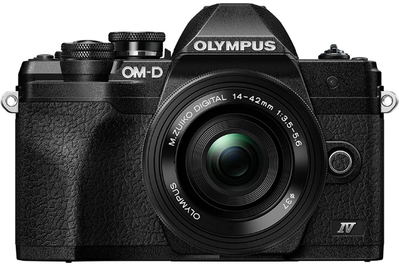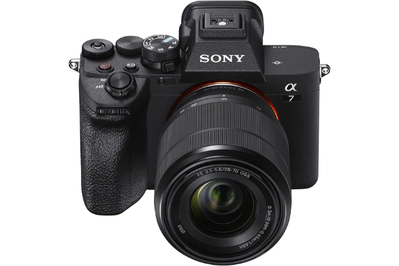
FYI
After our latest round of testing, we’ve concluded that the Olympus OM-D E-M10 Mark IV is the best mirrorless camera for most people and the Fujifilm X-T5 makes sense for more serious photographers.
May 2023
A mirrorless camera can give you better photos than your smartphone can, and it’s the best choice for anyone who wants to learn more about photography.
While DSLRs used to be the go-to option for improved image quality, mirrorless cameras have taken over thanks to their increased portability and reduced mechanical complexity.
After more than 220 hours of research and testing over the past seven years, we recommend the Olympus OM-D E-M10 Mark IV—a versatile, high-performing mirrorless camera that’s available at a great price.
Its advanced features help it capture reliably great-looking images in all kinds of conditions, and its small size means you’re more likely to carry it with you everywhere.
Our pick

Olympus OM-D E-M10 Mark IV
The best mirrorless camera for most people
With this camera’s small size, vast lens selection, built-in stabilization, excellent autofocus, and reliable exposure, you can easily capture great images anywhere.
Although the Olympus OM-D E-M10 Mark IV doesn’t offer the absolute best image quality, it captures great-looking images and is a joy to use. But it really stands out from the mirrorless competition thanks to its compact, lightweight design and its low price.
It’s compatible with more lenses than any of our other picks, and all of them work with its impressive built-in image stabilization. The autofocus system locks on to subjects quickly and accurately, and the lock-on remains accurate even in dimly lit situations. Its smartphone app, which enables remote shooting and image transfer, is better than those of most rivals, too.
Because the OM-D E-M10 IV is so small, you’re more likely to bring this camera with you everywhere you go. But despite its small stature, it has a comfy grip, plenty of tactile controls, and a tilting touchscreen, which together make it one of the better-handling cameras in its class.
ADVERTISEMENT
Upgrade pick

Fujifilm X-T5
The best mirrorless camera for serious photographers
This retro-styled, weather-sealed camera is the best APS-C mirrorless camera you can buy, with ample customizable controls, great autofocus, excellent video, built-in stabilization, and outstanding images even in very low light.
If you’re serious enough to spend over $2,000 for a camera and lens bundle, the Fujifilm X-T5 is the best choice to bring your photography to a higher level.
The sensor puts out surprisingly clean, detailed, color-accurate images even when you shoot in especially dim lighting. And Fujifilm’s film simulations evoke nostalgic memories through clever application of color and tones, if you opt to use them.
The camera is rugged and weather sealed, has dedicated dials for all of your most-used settings, sports a large electronic viewfinder that gives you a great view of what you’ll get, and captures beautiful 4K video. Plus, its tilting screen and built-in image stabilization make shooting in challenging situations even more manageable than with our top pick.
Also great

Sony α7 IV
The best full-frame mirrorless camera
If you want to step up to a full-frame camera, this model offers the best image quality you can get, along with a tilting touchscreen, dual memory-card slots, and cutting-edge autofocus.
The full-frame Sony ɑ7 IV delivers the sharpest, cleanest images of any mirrorless camera in its price range, and with its tilting touchscreen, comfortable grip, and easy-to-use controls, it’s a joy to use.
Its excellent battery life and dual memory-card slots are meaningful improvements over what we’ve seen on any other full-frame mirrorless camera under $2,700.
Add its weather sealing, its fast burst shooting, and its AI-powered eye-tracking autofocus system, and the α7 IV is definitely the best full-frame mirrorless camera for your money—if you’re willing to spend this much. Most people don’t need to.
Everything we recommend
Our pick

Olympus OM-D E-M10 Mark IV
The best mirrorless camera for most people
With this camera’s small size, vast lens selection, built-in stabilization, excellent autofocus, and reliable exposure, you can easily capture great images anywhere.
Buying Options
Upgrade pick

Fujifilm X-T5
The best mirrorless camera for serious photographers
This retro-styled, weather-sealed camera is the best APS-C mirrorless camera you can buy, with ample customizable controls, great autofocus, excellent video, built-in stabilization, and outstanding images even in very low light.
Buying Options
Also great

Sony α7 IV
The best full-frame mirrorless camera
If you want to step up to a full-frame camera, this model offers the best image quality you can get, along with a tilting touchscreen, dual memory-card slots, and cutting-edge autofocus.
Buying Options
Looking for something else?
- Why We Don’t Recommend Buying a New DSLR Camera
- What Camera Should I Buy?
- The Best Vlogging Cameras and Gear
- The Best Superzoom Camera
Read more from Electronics
The research
- Why you should trust us
- Who this is for
- What you need to know about mirrorless cameras
- How we picked and tested
- Our pick: Olympus OM-D E-M10 Mark IV
- Upgrade pick: Fujifilm X-T5
- Our full-frame pick: Sony ɑ7 IV
- Other good mirrorless cameras
- What to look forward to
- The competition
Why you should trust us
I’m Wirecutter’s senior staff writer for camera and printer coverage, as well as the former senior technology editor for Popular Photography; prior to that I served as a senior camera editor at CNET.
In my role at Popular Photography, I was in charge of camera and lens testing procedures and personally field-tested all of the cameras, as well as many of the lenses, that the publication covered during my tenure.
I have been covering mirrorless cameras since the very first models were introduced in 2008.
Who this is for
If you want to move beyond the constraints of smartphone photography or are interested in learning what terms like shutter speed, aperture, and ISO mean (and even if you already know), buying a mirrorless camera probably makes sense for you.
Compared with DSLRs, mirrorless cameras are smaller and lighter. And instead of providing an optical viewfinder, which uses a mirror to bounce light that travels through the lens up to your eyeball, mirrorless cameras offer an electronic viewfinder (EVF), which shows a live feed from the sensor. That means you see exactly what you’ll get in the finished photo.
Combined, these factors make mirrorless cameras easier to carry around and less fussy to use than DSLRs, yet mirrorless cameras provide equal or better image quality. And as a bonus, you can easily adapt any film- or DSLR-era lens to any mirrorless camera body, giving new life to vintage equipment.
What you need to know about mirrorless cameras
Sensor size
All else being equal, a larger sensor size generally equates to better image quality.
The sensors in the cameras we recommend here are much larger than those in smartphones. Sensor sizes in mirrorless cameras, in ascending size order, include Four Thirds (as found in our top pick), APS-C (as found in our upgrade pick), full-frame (as found in our also-great pick), and even medium format (which is far too expensive for us to recommend, at least for now).
At equal pixel counts, larger sensors have larger pixels, which gather more light; that reduces image noise (tiny unwanted speckles) and increases detail. They can also produce shallower depth of field, which helps to create dreamier out-of-focus backgrounds but also makes getting your subject correctly in focus more difficult.
Portability
Mirrorless cameras were created to be more portable than digital single-lens reflex cameras. Because camera makers don’t have to incorporate the SLR mirror or other parts associated with moving that mirror up and down, they can design a smaller camera.
Although some newer mirrorless cameras include large grips that make them quite chunky, they’re still smaller and lighter overall (and especially thinner) than equivalent DSLRs.
Unlike DSLRs, mirrorless cameras come in lots of different designs, from DSLR-shaped to rangefinder-styled. As a result, anyone can find a model that suits their style of shooting, and you have plenty of options that are small enough that you won’t think twice about bringing your camera with you wherever you go.
Battery life
With small camera bodies come smaller batteries, which means fewer photos captured per charge.
Camera makers are starting to get better about this—but especially in models aimed at beginners, manufacturers are still sacrificing some battery life in favor of a smaller camera.

